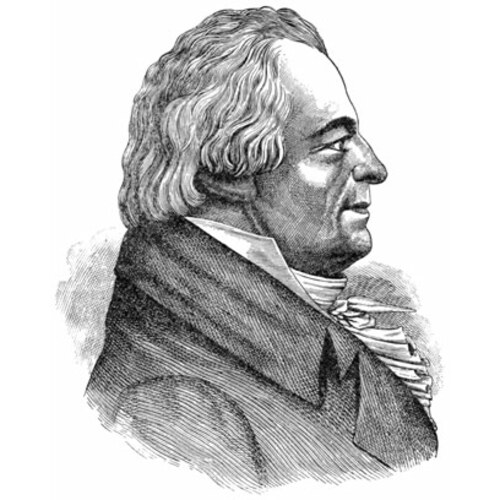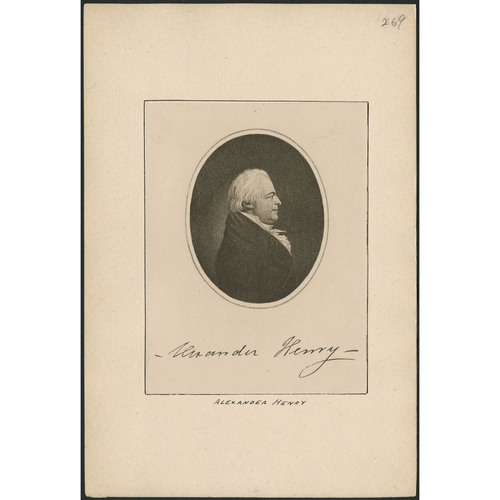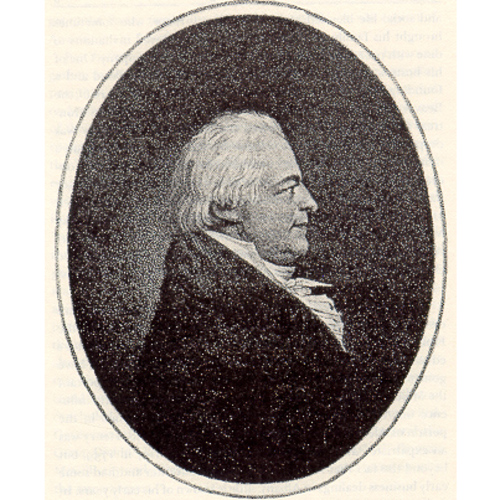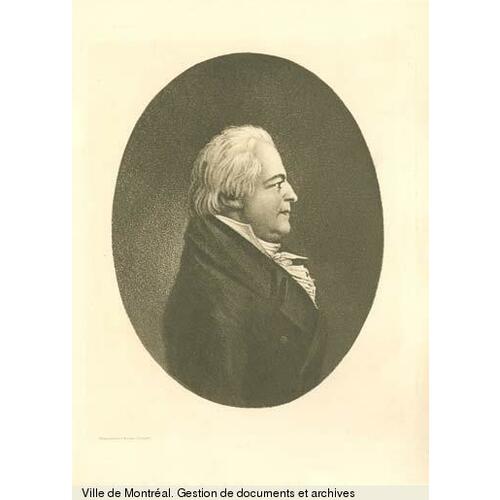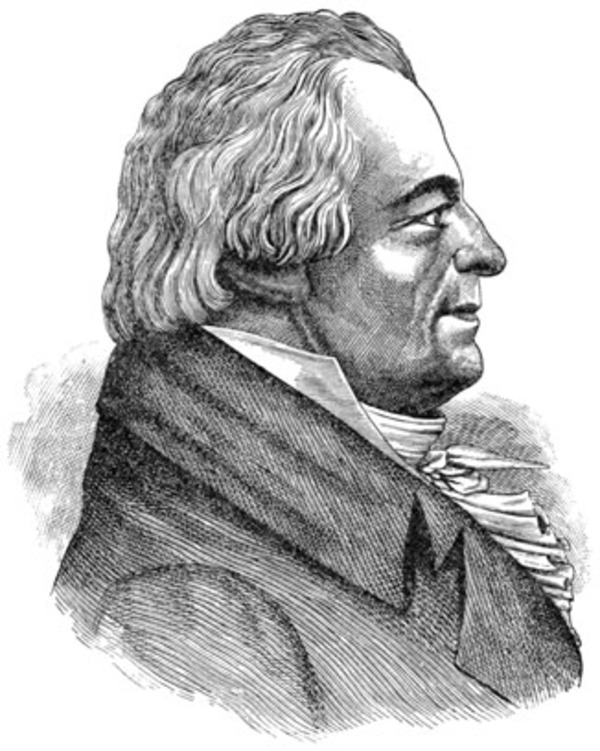
Source: Link
HENRY, ALEXANDER, fur trader, merchant, militia officer, jp, and author; b. August 1739, possibly the third son of Alexander Henry, a merchant of New Brunswick, N.J., and Elizabeth –; d. 4 April 1824 in Montreal.
In 1760, at the age of 20, Alexander Henry was in charge of three loaded supply bateaux which were following Major-General Jeffery Amherst*’s advance along Lake Ontario to Montreal. Henry, a merchant working out of Albany, N.Y., made a lucrative but hazardous living supplying the British army.
When Montreal surrendered on 8 September and Canada became open to English traders, Henry immediately travelled to Albany to purchase merchandise. He sold the goods at Fort William Augustus (east of Prescott, Ont.) and in January 1761 pushed on towards Montreal. At Les Cèdres he met former fur trader Jean-Baptiste Leduc, who acquainted him with the possibilities of trading at Michilimackinac (Mackinaw City, Mich.) and around Lake Superior. After buying supplies in Albany that spring, Henry returned to Montreal and secured a fur-trade pass from Major-General Thomas Gage*. He was the second Englishman to do so, Henry Bostwick having preceded him by a few days.
Following the Ottawa River–Lake Nipissing–French River route, Henry proceeded to Michilimackinac with his guide and assistant, Étienne-Charles Campion*, arriving in early September 1761. Britain and France were still at war and France’s Indian allies remained hostile to the British. Apprehensive about how he would be received, Henry disguised himself as a French trader, but the stratagem was unsuccessful. One of the war chiefs of the local Ojibwas, Minweweh*, soon learned of him; he and 60 warriors, “each with his tomahawk in one hand, and scalping-knife in the other,” paid Henry a visit. After first threatening Henry, Minweweh offered friendship. Henry and the other English traders at the post, Ezekiel Solomons and James Stanley Goddard, were nevertheless relieved when British soldiers finally arrived to take over the fort from Charles-Michel Mouet* de Langlade.
During the winter of 1761–62 or the following spring a minor Ojibwa chief, Wawatam*, adopted Henry as a brother. In May Henry went to Sault Ste Marie (Mich.), where he met fur trader Jean-Baptiste Cadot*. His ability to get along well with both the French and the Indians greatly facilitated his trading activities. After a fire late in December destroyed the small fort at the Sault garrisoned by Lieutenant John Jamet*, Cadot and Henry in February brought Jamet through the deep snow to Michilimackinac. Returning to the Sault in the spring of 1763, Henry met Sir Robert Davers*, who was touring the Upper Lakes, and accompanied him back to Michilimackinac.
In the spring of 1763 the Ottawa chief Pontiac* launched an uprising of the Indian nations against the British posts in the northwest. On 2 June Ojibwa warriors led by Madjeckewiss* and Minweweh attacked the British garrison at Michilimackinac. Henry hid for a time in Mouet de Langlade’s house, but was later discovered and captured. He was rescued by Wawatam and lived with the chief’s family for nearly a year, following them on their seasonal moves to hunting or fishing territories. Late in April 1764 the band returned to Michilimackinac to trade their furs. When some Ojibwas from Saginaw Bay plotted to kill Henry, Wawatam permitted him to go to Sault Ste Marie to seek the protection of Cadot. Madjeckewiss then came to the Sault seeking Henry’s life, but Cadot dissuaded him. When word was received that Sir William Johnson* was holding a peace conference at Fort Niagara (near Youngstown, N.Y.), the Ojibwas decided to attend and Henry joined them. But, eager to return to Michilimackinac in order to recover his property, Henry accompanied Colonel John Bradstreet*’s expedition from Niagara to Detroit and then joined Captain William Howard’s troops, who reoccupied Michilimackinac on 22 September.
Early in 1765 Henry secured from Howard a licence to trade in the Lake Superior area and in July he formed a partnership with Cadot. While trading with the Indians, Henry occasionally represented Robert Rogers*, the new commandant at Michilimackinac. Henry would complain to Johnson that Rogers had not paid him for his efforts. In 1767–68 he wintered at Michipicoten (Michipicoten River, Ont.) and later in 1768 entered into a partnership headed by Alexander Baxter to mine silver found in copper ore on the shores of Lake Superior. In the winter of 1770 the mining company built a sailing vessel at the Sault and used it to search for and transport copper. The scarcity of labour and the costs of transporting the ore made the venture unprofitable and the company wound up its affairs in 1774.
Fortunately, Henry had continued in the fur trade, and in 1775, eager to see some new country, he took four large and twelve small canoes into the territory northwest of Lake Superior. There he, Cadot, and other pedlars, including Peter Pond* and Joseph* and Thomas Frobisher, challenged the Hudson’s Bay Company. On 14 Oct. 1775 the group stopped at Cumberland House (Sask.), where Matthew Cocking* recorded their arrival. After setting up a trading post on Beaver Lake (Amisk Lake), Henry set off in January to Fort des Prairies (Fort-à-la-Corne) on the Saskatchewan River in order to see the plains. Having satisfied his curiosity and secured some furs from the Assiniboins, he returned to Beaver Lake. In the early spring he went to the Churchill River, where he purchased 12,000 additional beaver skins from Chipewyans probably on their way to trade at Hudson Bay, and then returned to Beaver Lake and rounded up his furs. Some of the last packs were forcibly acquired from Robert Longmoor*, an HBC employee who traded nearby. Henry set off in July for Montreal, laden with prime furs. He gave the governor, Sir Guy Carleton*, a large map of the western region through which he had travelled.
His imagination captivated by the rich potential of the northwest, Henry sailed to England in the autumn of 1776 and presented to the HBC a proposal that he recruit Canadian canoeists to work for the company. Bearing a letter of introduction from former fur trader Luc de La Corne* to his brother Abbé Joseph-Marie de La Corne* de Chaptes, Henry crossed the English Channel to France, where the abbé introduced him to the young queen, Marie-Antoinette.
In the spring of 1777 Henry returned to British North America and in partnership with Jean-Baptiste Blondeau took a trading canoe to Michipicoten. That fall he sold his post there to Jean-Baptiste Nolin. The following year, in partnership with John Chinn, he traded at Sault Ste Marie, working closely with Cadot. Henry travelled to England in the fall of 1778 and again in 1780. On 18 Oct. 1781, after returning to Montreal from his third and last visit to England, he sent to naturalist Sir Joseph Banks* a detailed plan for an expedition to find an overland route to the Pacific.
Henry settled in Montreal, where he became a general merchant, but he remained involved in the fur trade and made occasional trips to Detroit or Michilimackinac. In 1784 he seriously considered moving to Schenectady, N.Y., so that he could continue trading at Detroit and Michilimackinac, which had been given to the United States by the Treaty of Paris. When the British did not immediately evacuate the western posts, Henry remained in Montreal. On 11 June 1785 he married a widow, Julia Ketson. Their eldest child, Julia, had been born in October 1780. Four sons, Alexander, William, Robert, and John, were born between 1782 and 1786. By the time of his marriage Henry had become a prominent merchant. In February 1785 he and 18 other traders who had been active in the northwest had founded the Beaver Club. The following spring he apparently suffered a severe financial set-back, perhaps as a result of unsettled economic conditions following the end of the American revolution and the intertribal warfare around the western Great Lakes [see Wahpasha*]. To recoup his losses, Henry again traded at Michilimackinac from 1785 to 1790. There, in the summer of 1788, he was a representative of the General Company of Lake Superior and the South (also known as the General Society) at a court of inquiry which examined charges of misusing government supplies levelled against the interpreter Joseph-Louis Ainsse*.
During the mid 1780s Henry encouraged a friend in New York, William Edgar, to enter the trade in furs with China. Fascinated by the prospects offered by the Pacific coast, Henry passed on his ideas, which he called “my favorite plan,” to New York merchant John Jacob Astor. He introduced Astor into the Canadian trade and Astor was Henry’s guest during his annual visits to Montreal. In the 1790s Henry and Astor assisted the North West Company in organizing shipments of furs to China [see Simon McTavish*].
Over the years Henry maintained close personal ties with John Askin*. During the mid 1790s they were involved in several unsuccessful land speculation schemes in northern Ohio. One of these, known as the Cuyahoga Purchase, came to naught when the Ohio Indians, from whom the land had been acquired, refused to bring forth their land claims at the Treaty of Greenville (1795) and the deeds which had been obtained by Henry and his associates, Askin, Patrick McNiff*, and others, were considered invalid. Henry moaned, “We have lost a fortune of at least one Million of Dollars.”
On 14 Sept. 1792 Henry and his nephew Alexander Henry* the younger together obtained one share in the NWC for six years. In 1796 he sold his interest to William Hallowell but he continued to buy furs from traders and export them to England. When one of his uninsured shipments was captured by the French in 1801, he suffered a serious financial crisis. In order to repair his fortunes, Henry in 1802 became a commission merchant and auctioneer in partnership with William Lindsay. Plagued by ill health, he worked hard at a job he did not find satisfying. Yet, despite his reverses, he maintained a secure place in Montreal’s mercantile society. He served as a captain in the militia and from 1794 to 1821 as justice of the peace, entertained leading merchants in his home, regularly signed petitions and memorials, and attended parties. He was particularly active in the Beaver Club, reactivated in 1807, of which he was the senior member.
Henry sensed, however, that new men were taking over the fur trade and in 1809 he wrote to Askin, “There is only us four old friends [James McGill*, Isaac Todd*, Joseph Frobisher, and himself] alive, all the new North westards are a parcel of Boys and upstarts, who were not born in our time, and suposes they know much more of the Indian trade than any before them.” To recapture his exciting past, he wrote a memoir of his life which he published in New York in 1809. Travels and adventures in Canada and the Indian territories, between the years 1760 and 1776 has become an adventure classic and is still considered one of the best descriptions of Indian life at the time of Henry’s travels.
During the latter years of his life, Alexander Henry continued to trade and in 1812 was appointed vendue master and auctioneer for the district of Montreal. He worked in partnership with his nephew Norman Bethune, who lived with him at 14 Rue Saint-Urbain. A middle-sized man, easy yet dignified, Henry had been called by the Indians “the handsome Englishman.” At age 85 he died in Montreal, esteemed by all who knew him.
Alexander Henry is the author of Travels and adventures in Canada and the Indian territories, between the years 1760 and 1776 (New York, 1809). Several editions have appeared, including one prepared by James Bain (Boston, 1901) and another edited and introduced by M. M. Quaife (Chicago, 1921). Its first part was reprinted as Attack at Michilimackinac . . . , ed. D. A. Armour (Mackinac Island, Mich., 1971).
ANQ-M, CE1-63, 11 juin 1785. British Museum (Natural History) (London), Banks coll., DTC 2: 39–51 (copy). Clements Library, Thomas Gage papers. McCord Museum, J.-B. Blondeau, account-book; Beaver Club minute-book, 1807–27. Mo. Hist. Soc. (St Louis), Chouteau coll. MTL, North West Company papers, William Edgar papers, Alexander Henry to William Edgar, 11 Aug. 1784–22 Oct. 1787 (typescripts); Alfred Sandham coll., Alexander Henry to Forsyth & Taylor, 9 Dec. 1786. PAC, MG 19, A2, ser.1, 3; A4 (copies); RG 4, B28, 115. “Biographical sketch of the late Alexander Henry, esq.,” Canadian Magazine and Literary Repository (Montreal), 2 (January–June 1824): 289–304, 385–97. Docs. relating to NWC (Wallace). Documents relating to the colonial, revolutionary and post-revolutionary history of the state of New Jersey, ed. W. A. Whitehead et al. (42v., Newark, N.J., 1880–1949). John Askin papers (Quaife). Journals of Samuel Hearne and Philip Turnor, ed. J. B. Tyrrell (Toronto, 1934; repr. New York, 1968). Mich. Pioneer Coll. The papers of Sir William Johnson, ed. James Sullivan et al. (14v., Albany, N.Y., 1921–65), 4–6, 12. [Robert] Rogers, “Rogers’s Michillimackinac journal,” ed. W. L. Clements, American Antiquarian Soc., Proc. (Worcester, Mass.), new ser., 28 (1918): 224–73. Wis., State Hist. Soc., Coll., 3 (1857): 76–82; 19 (1910): 67–68, 238, 253–54, 280–85, 289–91, 309–10, 336–37, 372–74. Innis, Fur trade in Canada (1962). Morton, Hist. of Canadian west (Thomas; 1973). K. W. Porter, John Jacob Astor, business man (2v., Cambridge, Mass., 1931; repr. New York, 1966). J. U. Terrell, Furs by Astor (New York, 1963). Charles Lart, “Fur trade returns, 1767,” CHR, 3 (1922): 351–58.
Cite This Article
David A. Armour, “HENRY, ALEXANDER (1739-1824),” in Dictionary of Canadian Biography, vol. 6, University of Toronto/Université Laval, 2003–, accessed April 2, 2025, https://www.biographi.ca/en/bio/henry_alexander_1739_1824_6E.html.
The citation above shows the format for footnotes and endnotes according to the Chicago manual of style (16th edition). Information to be used in other citation formats:
| Permalink: | https://www.biographi.ca/en/bio/henry_alexander_1739_1824_6E.html |
| Author of Article: | David A. Armour |
| Title of Article: | HENRY, ALEXANDER (1739-1824) |
| Publication Name: | Dictionary of Canadian Biography, vol. 6 |
| Publisher: | University of Toronto/Université Laval |
| Year of revision: | 1987 |
| Access Date: | April 2, 2025 |


